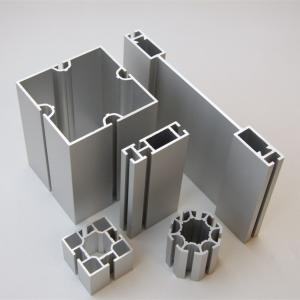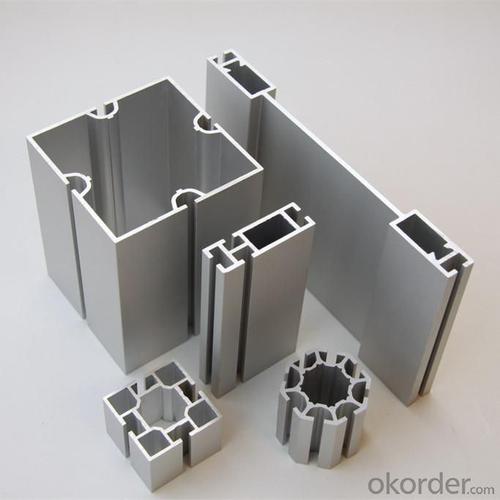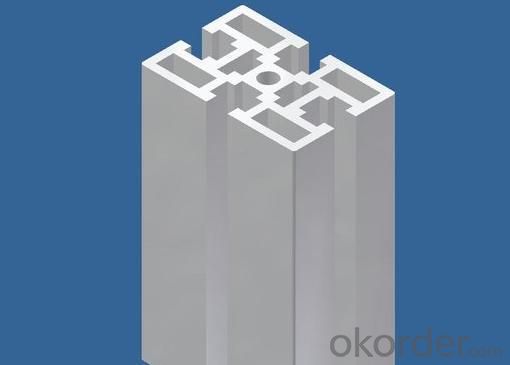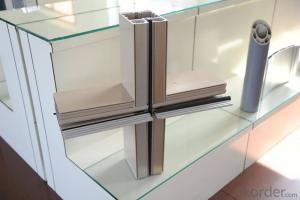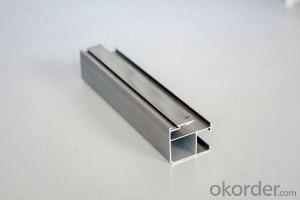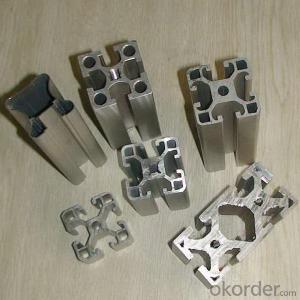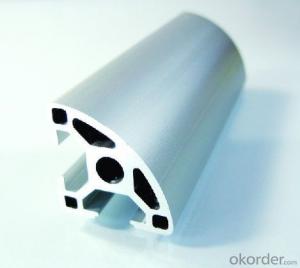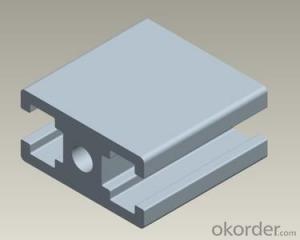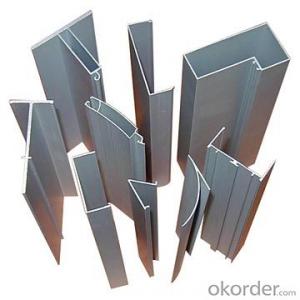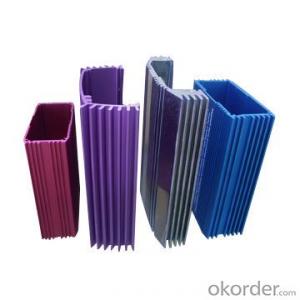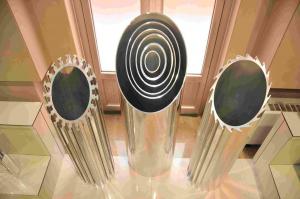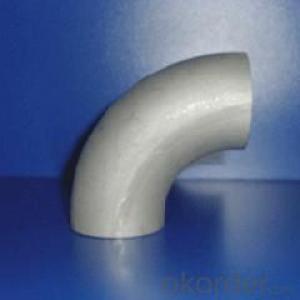2020 T-Slot Aluminum Profiles Extrusion 6063-T5
- Loading Port:
- ShenZhen
- Payment Terms:
- TT or LC
- Min Order Qty:
- 5 Tons kg
- Supply Capability:
- 1000 Tons Per Month kg/month
OKorder Service Pledge
OKorder Financial Service
You Might Also Like
1 Specifications of Aluminum Profiles 6063-T5
Alloy Number | 6063 6061 6060 and different aluminium alloy |
Temper | T4 T5 T6 or other special status |
Surface available | Mill finish, Anodized, Powder Coating, Wooden transfering, electrophoresis, heat insulation, PVDF, and deep processing |
Thickness: | >0.8mm |
Width: | <300mm |
Standard | GB5237.1-2008 |
Special Specification is available on customer’s requirement
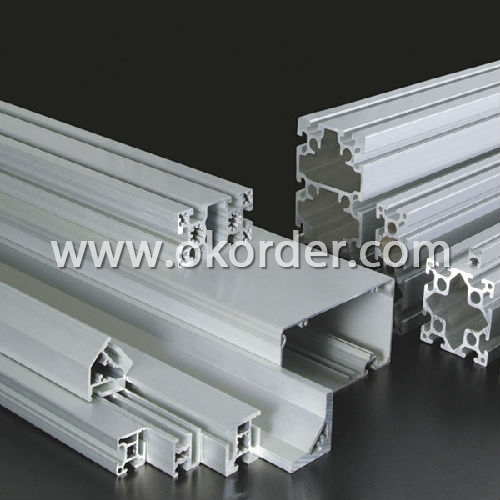
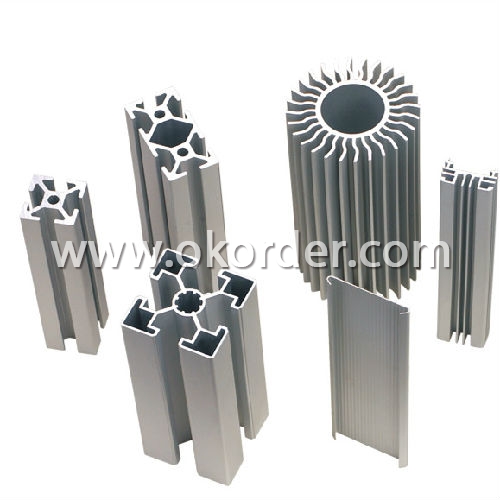
2 Usage/Applications of Aluminum Profiles 6063-T5
Aluminium Profiles are widely used in construction(windows & doors,curtain wall), decoration ( flooring and tiling, kitchen) and industry ( heat sink ).
CNBM produces aluminum profiles which meets the national standard GB5237.1-2008. Our strong quality control term bring you the most-qualified products. And with state-of-the-art equipment, and the state owned company background, we have to say, you will understand why there are so many company choose CNBM to be their supplier.
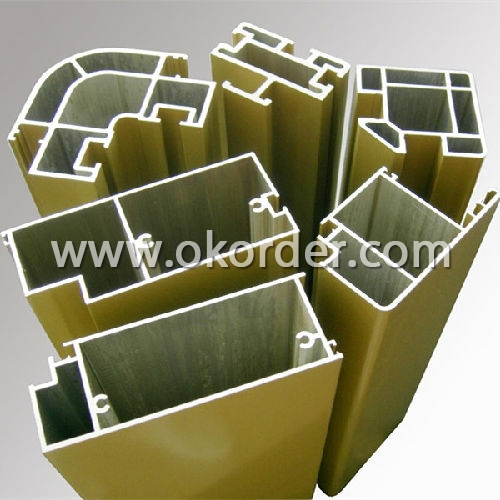
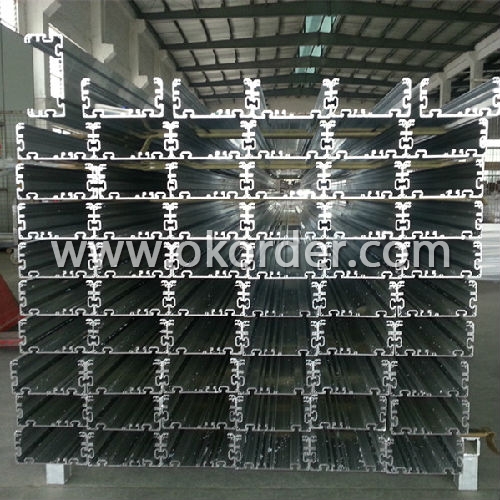
3 Packaging & Delivery of Aluminum Profiles 6063-T5
Packaging: Seaworthy package, bubble plastic bag inside, anti-moisture paper wrapped outside, covered with cartons, on wooden pallets, in containers.
Shipment: the goods will be delivered in 15-30days after getting the buyer's payment.
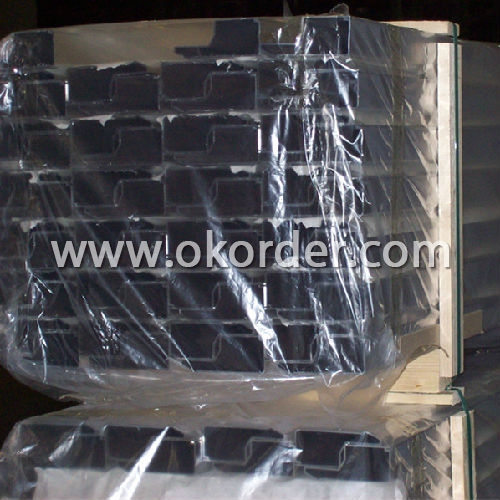
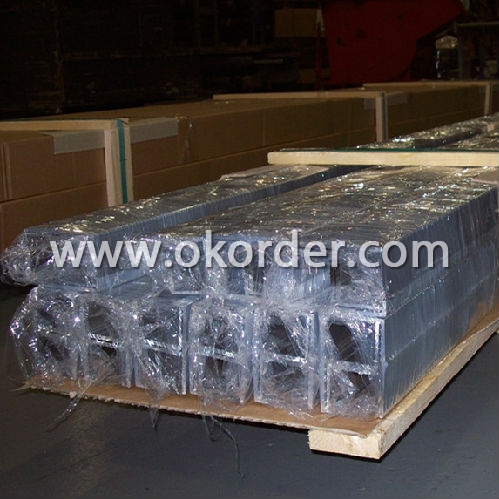
4 Production Flow of Aluminum Profiles 6063-T5
aluminium ingot & alloy→melting and casting→extrusion→powder coating→pouring rubber for heat insulation→checkout→packing→PVDF coating\anodizing\electrophoresis→put in products warehouse.
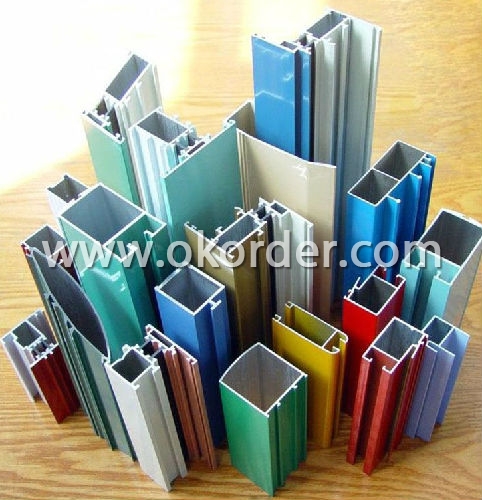
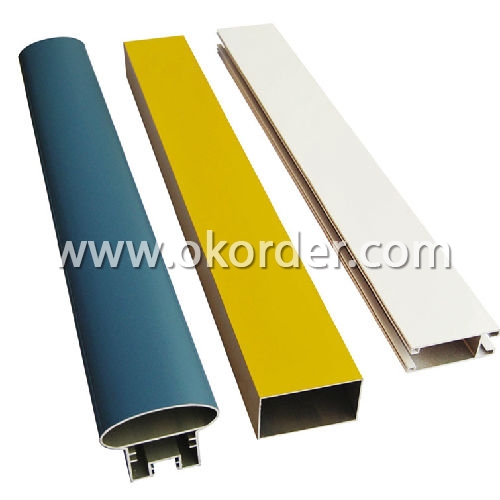
- Q: How do I choose the right aluminum profile for my project?
- When choosing the right aluminum profile for your project, there are several factors you should consider. Firstly, you need to determine the specific requirements of your project. Consider the purpose and function of the aluminum profile, as well as any specific dimensions or specifications it needs to meet. This will help you narrow down your options and ensure you choose a profile that is suitable for your project. Next, think about the type of aluminum profile that would be most appropriate for your project. There are various types available, such as T-slotted profiles, angle profiles, or channel profiles. Each type has its own advantages and applications, so it's important to understand the differences and select the one that best fits your needs. Consider the strength and durability of the aluminum profile. Evaluate the load-bearing capacity and resistance to corrosion or other environmental factors. Depending on the nature of your project, you may need a profile that can withstand heavy loads or harsh conditions. Another important factor to consider is the compatibility of the aluminum profile with other components or systems. If you plan to use the profile in conjunction with other materials or hardware, ensure they are compatible and can be easily integrated. Additionally, take into account the cost and availability of the aluminum profile. Compare prices from different suppliers and consider the availability of the profile in the required quantity and timeframe. Lastly, it can be beneficial to seek expert advice or consult with professionals who have experience working with aluminum profiles. They can provide valuable insights and recommendations based on their knowledge and expertise. By considering these factors, you can make an informed decision and choose the right aluminum profile that will meet the specific requirements of your project.
- Q: How much does aluminum mold need?
- To see the aluminum circle size and large extrusion machine for production, to determine how much the mold fee. Besides, the die fee is returned, provided that how many tons of products are reached.
- Q: Are aluminum profiles suitable for automotive heat exchangers?
- Automotive heat exchangers can effectively utilize aluminum profiles due to their numerous advantages. Firstly, aluminum possesses outstanding thermal conductivity, enabling efficient heat transfer between mediums. This quality allows aluminum heat exchangers to effectively dissipate heat generated by vehicle components such as the engine or transmission. Secondly, aluminum profiles are both lightweight and strong, making them a preferred option in the automotive industry. Weight reduction is crucial for improved fuel efficiency and performance, and aluminum heat exchangers contribute to this goal. By utilizing aluminum, overall weight is reduced, resulting in better handling, acceleration, and energy efficiency. Furthermore, aluminum exhibits high resistance to corrosion, even in harsh environments, making it highly suitable for automotive applications. This corrosion resistance ensures the durability and reliability of heat exchangers, reducing maintenance and replacement costs. Additionally, the manufacturing and formation of aluminum profiles into complex shapes is a simple task. This flexibility in design allows for customized heat exchanger designs that meet specific automotive requirements. The ability to efficiently utilize available space and maximize heat exchange surface area enhances overall performance. In conclusion, aluminum profiles are an excellent choice for automotive heat exchangers due to their exceptional thermal conductivity, lightweight yet strong properties, corrosion resistance, and design flexibility. These qualities make aluminum the ideal material for effectively managing heat in vehicles, resulting in improved performance, fuel efficiency, and durability.
- Q: Can aluminum profiles be used in the production of packaging materials?
- Yes, aluminum profiles can be used in the production of packaging materials. Aluminum is a versatile material known for its strength, durability, and lightweight properties, making it an ideal choice for packaging applications. Aluminum profiles can be extruded into various shapes and sizes, allowing for customized packaging solutions. These profiles can be used to manufacture packaging containers, such as cans, bottles, and tubes, which are commonly used for food, beverages, pharmaceuticals, cosmetics, and other consumer products. The use of aluminum profiles in packaging materials offers numerous advantages, including resistance to corrosion, impermeability to light, oxygen, and moisture, and the ability to be easily formed and printed on. Additionally, aluminum is a fully recyclable material, making it a sustainable choice for packaging production. Overall, aluminum profiles are a reliable and efficient option for the production of packaging materials.
- Q: What are the advantages of using aluminum profiles in the aviation industry?
- The aviation industry benefits from several advantages when utilizing aluminum profiles. To start with, the lightweight nature of aluminum is of utmost importance. In aviation, this characteristic plays a crucial role in reducing overall aircraft weight, ultimately leading to enhanced fuel efficiency. Manufacturers of aircraft can employ aluminum profiles to develop lighter structures without compromising on strength and durability. Furthermore, aluminum displays exceptional resistance to corrosion. This proves especially valuable in the aviation sector where aircraft are exposed to severe environmental conditions like high humidity, temperatures, and saltwater exposure. Aluminum profiles can withstand these conditions, effectively preventing corrosion and ensuring the long-lasting lifespan of the aircraft. In addition, aluminum profiles offer an impressive strength-to-weight ratio. This means they provide a sturdy and inflexible structure while remaining lightweight. This quality is essential for ensuring the structural integrity and safety of the aircraft. Aluminum profiles can endure the stresses and loads encountered during flight, thereby contributing to the overall safety of the aircraft. Moreover, aluminum is highly malleable, making it easy to shape and mold into intricate designs. This characteristic allows for greater design flexibility in aircraft manufacturing, enabling manufacturers to create aerodynamic and efficient structures. Aluminum profiles can be fabricated, welded, and joined with ease, providing convenience in manufacturing and assembly within the aviation industry. Lastly, aluminum is an incredibly recyclable material. With the growing emphasis on sustainability, utilizing aluminum profiles in aircraft construction helps reduce the carbon footprint. Aluminum can be recycled and reused multiple times without compromising its advantageous properties, making it an environmentally friendly choice. In conclusion, the utilization of aluminum profiles in the aviation industry offers numerous advantages, including lightweight construction, corrosion resistance, high strength-to-weight ratio, design flexibility, and recyclability. These properties position aluminum as an ideal material for aircraft manufacturing, contributing to improved fuel efficiency, safety, and sustainability.
- Q: Including the element parameters, the price and the difference between 6063, what is the use and so on!How about 6060 100/ meters? How much is the strength? How much is the price more than 6063?
- 6060 aluminum material compositionSi:0.3-0.6, Fe:0.1-0.3, Cu:0.1, Mn:0.1, Mg:0.35-0.6, Cr:--, Zn:0.1, others:Ti:0.15 other total: 0.15 Al: marginPerformance: tensile strength B (MPa): more than 470 conditions yield strength of 0.2 (MPa): more than 420 elongation 5 (%): 6Product features: 1. high strength, heat treatable alloy.2., good mechanical properties,.3. good usability,.4. easy processing, good wear resistance,.5. corrosion resistance, good oxidation resistanceMain uses: Aviation fixtures, truck, tower building, ships, pipelines and other applications requiring strength, weldability and corrosion resistance of the building on the field. Such as: aircraft parts, camera lens, coupler, ship fittings and accessories, electronic accessories and fittings, decoration or various hardware, hinge head head, piston, piston, hydraulic brake, electric appliance fittings, valves and valve parts.6063 aluminum chemical composition:Al Al: residual silicon Si:0.20 ~ 0.6 copper Cu: less than 0.10 mg Mg:0.45 ~ 0.9 zinc Zn: Mn: Mn = 0.10 = 0.10 Ti = 0.10 Cr: titanium chromium iron: less than or equal to 0.10 Fe:0.000 ~ 0.350 note: single: = 0.05; total: 0.15The density of 6063 is 2.69g/cm3
- Q: Can aluminum profiles be used for security doors and windows?
- Yes, aluminum profiles can be used for security doors and windows. Aluminum is a strong and durable material that is resistant to corrosion, making it an ideal choice for security applications. Aluminum profiles can be designed and manufactured to meet specific security requirements, such as reinforced frames, multi-point locking systems, and impact-resistant glass. Additionally, aluminum profiles offer a sleek and modern aesthetic, allowing for the creation of stylish security doors and windows. Overall, aluminum profiles provide a reliable and secure solution for enhancing the safety and protection of both residential and commercial properties.
- Q: What are the potential effects on the environment when aluminum profiles are used in the construction of buildings?
- <p>The use of aluminum profiles in building construction has both positive and negative environmental impacts. On the positive side, aluminum is lightweight, which reduces the energy required for transportation and can contribute to a building's energy efficiency. It is also recyclable, with a high recycling rate, which helps to conserve resources and reduce waste. However, the production of aluminum is energy-intensive and generates greenhouse gas emissions. Additionally, the extraction of bauxite, the primary source of aluminum, can lead to deforestation and habitat destruction. The environmental impact of using aluminum profiles in construction must therefore be balanced against these factors.</p>
- Q: What are the different welding options available for aluminum profiles?
- There are several welding options available for aluminum profiles, each with its own advantages and considerations. The most common welding methods for aluminum profiles include: 1. Tungsten Inert Gas (TIG) Welding: TIG welding is one of the most widely used methods for aluminum. It uses a non-consumable tungsten electrode to produce the weld, while an inert gas, such as argon, protects the weld area from atmospheric contamination. TIG welding offers excellent control over the heat input, resulting in high-quality, precise welds. It is suitable for thin aluminum profiles and provides a clean appearance, but it can be time-consuming and requires skilled operators. 2. Metal Inert Gas (MIG) Welding: MIG welding, also known as Gas Metal Arc Welding (GMAW), is another popular method for aluminum profiles. It uses a consumable wire electrode that continuously feeds into the weld pool, while an inert gas shield protects the weld area. MIG welding is faster than TIG welding and is suitable for both thin and thick aluminum profiles. However, it may produce more spatter and requires proper preparation and shielding gas selection. 3. Friction Stir Welding (FSW): Friction stir welding is a solid-state joining process that uses a rotating tool to generate heat and mechanically stir the aluminum profiles together. FSW is particularly suitable for thick aluminum profiles and offers high joint strength, excellent fatigue resistance, and minimal distortion. However, it requires specialized equipment and may not be suitable for all profile shapes. 4. Laser Beam Welding (LBW): Laser beam welding uses a highly concentrated laser beam to melt and join aluminum profiles. It provides a narrow and deep weld with minimal heat input, resulting in low distortion and high welding speeds. LBW is suitable for both thin and thick profiles, but it requires expensive equipment and skilled operators. 5. Resistance Spot Welding (RSW): Resistance spot welding uses electrical current and pressure to create welds by melting and joining aluminum profiles at specific points. RSW is commonly used for thin aluminum profiles and offers high productivity and repeatability. However, it requires access to both sides of the profiles and may leave visible marks on the surface. It is important to consider the specific requirements of your aluminum profile welding project, such as profile thickness, joint type, appearance, and production volume, to determine the most suitable welding method. Consulting with a welding professional or engineer can help ensure the best choice for your specific application.
- Q: How to calculate the spraying powder of aluminium profile?
- Powder consumption is calculated according to the thickness of the coating film, powder density according to 1.2-1.6g/ cm fand effective coating rate of 50-70% formula, don't I teach.
1. Manufacturer Overview
| Location | Guangdong, China |
| Year Established | 2006 |
| Annual Output Value | Above US$50 Million |
| Main Markets | Mid East;Eastern Europe;North America |
| Company Certifications | ISO 9001:2000;ISO 14001:2004;OHSAS 18001 |
2. Manufacturer Certificates
| a) Certification Name | |
| Range | |
| Reference | |
| Validity Period |
3. Manufacturer Capability
| a) Trade Capacity | |
| Nearest Port | Nanhai Port |
| Export Percentage | 30%-50% |
| No.of Employees in Trade Department | 21-50 People |
| Language Spoken: | English;Chinese |
| b) Factory Information | |
| Factory Size: | Above 100,000 square meters |
| No. of Production Lines | Above 10 |
| Contract Manufacturing | OEM Service Offered;Design Service Offered |
| Product Price Range | Average |
Send your message to us
2020 T-Slot Aluminum Profiles Extrusion 6063-T5
- Loading Port:
- ShenZhen
- Payment Terms:
- TT or LC
- Min Order Qty:
- 5 Tons kg
- Supply Capability:
- 1000 Tons Per Month kg/month
OKorder Service Pledge
OKorder Financial Service
Similar products
Hot products
Hot Searches
Related keywords
